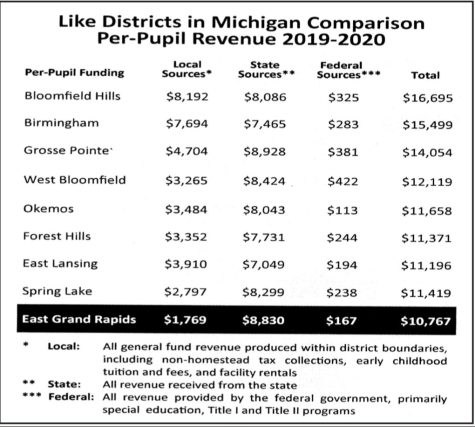School Funding Analysis: Where Does Our Money Go?
![]() The federal government is providing three rounds of COVID relief to Michigan intended to aid in educational gaps and obstacles created during the pandemic.
The federal government is providing three rounds of COVID relief to Michigan intended to aid in educational gaps and obstacles created during the pandemic.
In one round of federal stimulus from March of 2021, Michigan received $3.7 billion. Flint received the most funding per student at $27,000; East Grand Rapids received the least at $93. This amount of funds was made because East has the lowest poverty rating of any district.
Despite a lower amount of federal stimulus, Assistant Superintendent of Finance Operations Anthony Morey said the district received sufficient funding.

“We received sufficient federal funds and state funds to offset our additional COVID costs [last year],” he said. ‘This year, because we’re not a Title IA district, we’re receiving a lot less per-pupil so it’s making us appear to be less-well funded – well we are less well-funded – and we’re able to do fewer things because we don’t have the money.”
Morey’s mention of a Title I district refers to the federal grant program aiming to enhance student achievement in economically disadvantaged areas through increased financial aid. Designated Title I districts receive more federal funding to enrich and support learning.
Even before COVID, East Grand Rapids received significantly less funding than like-districts of a similar demographic. Among the three sources schools receive revenue from – local, state, and federal – the greatest disparity is in locally-sourced funding. According to last year’s district budget guide, Bloomfield Hills, a high-income district near Detroit, used $8,192 from local sources; East Grand Rapids used $1,769.
This gap is, in part, due to Proposal A, enacted in 1994. Previously, public schools received funding through property taxes. As a result, Michigan property tax burden was above the national average and there was a large wealth disparity among school districts across the state.
The introduction of Proposal A eliminated property taxes as schools’ main source of funding, instead establishing a minimum per-pupil foundation allowance, lowering the spending gap between low and high-spending school districts. This means that last year East received $8,830 per student; it also means low enrollment is “about the worst thing that can happen to a school district financially,” according to Morey.
But for some districts of an especially affluent demographic, such as Bloomfield Hills or Birmingham, Proposal A’s funding system would reduce their overall revenue. To maintain their pre-proposal revenue, a small number of districts qualified as “hold-harmless districts” that could levy additional mils (property taxes) with voter approval. East did not qualify for this designation.
“A lot of districts of higher socioeconomic status receive 31A funding,” Morey said, referencing a program meant to give more money to schools in lower-income areas. “They can do that under that Proposal A law.”
Morey also said that when the state has budget cuts, it impacts the school. The most notable year of decreased funding is the 2011-2012 school year. For the prior two years, the budget had not been increased, and then that year was eliminated by $470 per student.
“When there’s no increase, there’s program cuts,” Morey said. “That is really the result if the state doesn’t continue to increase funding at a sustainable level, is that programming will go down, or compensation of employees will be flat, or in some cases compensation cuts will have to occur.”
In an effort to generate money to make up for these budget cuts, donation-based streams of revenue are one measure of ensuring steady funding. In East, EGR Now was a program established to compensate for reduced funding. Other areas of a high-income demographic can enact similar programs to ensure they have sufficient funding during times of budget cuts.
Despite past budget cuts, this year’s fund balance has increased from around $3 million to more than $6 million.
Despite Proposal A’s attempt to increase equity among Michigan school districts, Morey said the state should be doing more.
“Our state government has not achieved an equitable funding platform,” Morey said. “The biggest determinant of the quality of education is the quality and skill of the teacher. The biggest way in which we can lift up our teachers is by paying them well. If we don’t have funding to support that, the quality of education will go down across the state.”
This article appeared in the February edition of The East Vision.









